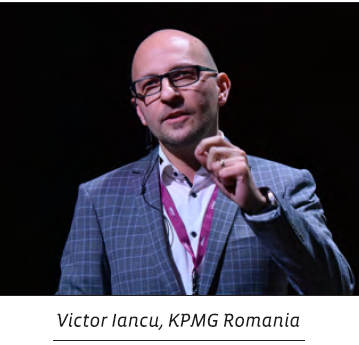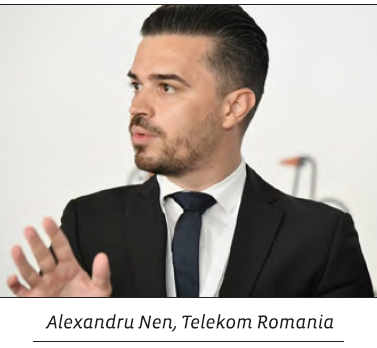With a growing urban population, cities in Romania have one way to cope with this big challenge: by becoming smarter and adopting a sustainable development model. In light of the pandemic, smart city transformation can no longer be seen as a “nice to have”; it is a must for cities of all sizes.
By Anda Sebesi
In recent years, the smart city concept has entered on the agenda of an increasing number of countries worldwide, including Romania. Although a clear definition of this concept may still be under debate, one thing is clear: a smart city implies a series of interconnected industries and a joint effort by citizens, central and local authorities, academia, and private companies. “A smart and sustainable city is an innovative city that uses data and communication technologies, as well as other means to improve the quality of life, the efficiency of urban operations and services, and competitiveness, in order to meet the needs of present and future generations from an economic, social, and environmental perspective,” says Eduard Dumitrascu, president of the Romanian Smart City Association.
According to Business Dictionary, a smart city is an urban area that creates a sustainable economic development and a high quality of life as a result of great performance in several key sectors like the economy, mobility, environment, people, life, and government.
Yet the pandemic has changed the way societies and cities work. According to Smart City Transformation in a post-COVID world study conducted by KPMG, smart city transformation can no longer be seen as a “nice to have”. COVID‑19 has resulted in us all experiencing different levels of isolation and a lack of connectedness. As we emerge from the immediate crisis, there is a unique opportunity to improve connection by embedding digital infrastructure and smart city initiatives as part of the business‑as‑usual design, development, operation, and maintenance of our cities.
“Smart cities are resilient cities and, through the integration of physical and digital environments, we can address the gaps in resilience exposed by COVID‑19. By harnessing data and digital technologies, we can re‑engineer flourishing, inclusive cities which are able to adapt in the face of change,” says the report.
The same report notes that importantly, a successful re‑imagination of cities requires adopting a human‑centred design approach that focuses on tapping into the collective intelligence of communities in order to understand the human experience from the diverse perspectives of the people who live, work, learn, and play in cities every day. This approach holds even greater value at a time when we are seeing an increased focus on the role of local neighbourhoods in strengthening community resilience.
Municipal infrastructure gaps remain prevalent in the European Union, especially for digitalization and climate change, particularly in Central and Eastern Europe. The EIB Municipality Survey 2020 highlights that even though municipalities have focused on developing digital, urban transport, and social infrastructures, their infrastructure investments remain insufficient. Other key factors are the length of regulatory process, regulatory uncertainty and lack of technical capacity to assess critical aspects of infrastructure, such as affordable housing or electric charging stations for vehicles.

“The first wave of the coronavirus pandemic reinforced the demand for more digital investment while rekindling the need for social infrastructure. How municipalities address green and digital challenges affects their outlook on climate change and is also related to local corporate innovation in these areas,” says Lara Tassan Zanin, head of the EIB Group Representation in Romania.
According to Zanin, municipal digital sophistication (such as providing online public services) and green administrative capacity (such as adherence to green budgeting) are associated with greater confidence for municipalities to assess the risks of the transition towards a low-carbon emission economy. “Municipalities that have jointly developed these attributes are also less pessimistic about the physical risks posed by climate change. The share of firms innovating and adopting technologies in digital and green areas rises with the share of municipalities that are digitally sophisticated and have developed green administrative capacities,” she says.
In terms of funding, municipalities are less able to close investment gaps if they are more reliant on capital transfers or grants. This poses a challenge for EU cohesion, since the inability to close investment gaps primarily affects municipalities in less economically developed regions. “For the EIB, investment in smart cities and regions is a way to respond efficiently to its social and territorial cohesion mandate by supporting the upgrade of local economies in a quickly evolving digital world. Cities and regions are key partners for the EIB. The EU Bank supports projects to make cities more sustainable (energy transition, climate adaptation, and efficient mobility), inclusive (housing, health care, and integration of migrants), and competitive (education, skills development, and digital transition). With its advisory, the EIB can help cities with their investment planning and coordination, which is often a weak spot for municipalities across Europe,” the EIB representative adds.
The city of Oradea is an excellent example on making the best use of the EIB advisory and lending support, in combination with EU funds. Since 2007, Oradea and EIB have signed three framework loans to support urban regeneration and geothermal schemes, as well as the acquisition of public transport rolling stock. “We are now working on a fourth loan to support Oradea in achieving its ambitions of becoming a green and digital Future City: EIB-EU JASPERS advisory has helped prepare the zero-emission buses purchase scheme, including the EU grant application. The EIB’s involvement will accelerate EU funds absorption and improve the promoter’s financial profile by diversifying its funding base, increasing its debt maturity structure, and lowering its average cost of funding,” Zanin concludes.
Community involvement crucial for smart cities

According to Victor Iancu, advisory director at KPMG Romania, a smart city cannot be imagined without actively involving the community, its citizens. The operating model of a smart city combines technology with citizen interaction, the latter being analysed and understood in advance, down to the smallest detail.
“For example, the way a technology company carefully and systematically studies the types of potential customers on the market, their needs, aspirations, and behaviours, to ensure the widest possible adoption of the products and services they create (and achieve commercial success), is similar to how cities must position themselves when planning and creating smart infrastructures for their citizens,” Iancu suggests. He adds that in any given project, putting people first ensures that meeting the real needs of the community remains a priority, without falling prey to the temptation to come up with generic, mass solutions. “This approach not only sets out very clearly the ‘why’ and ‘who’ the facilities of a smart city address, but citizens also become an integral part of the solution, get ownership in the process, and gain trust. All of these ensure the right targeting of smart solutions, leading to the success of smart city investments,” Iancu argues.
He also suggests that the above aspects require a mindset shift in the way local administrations relate to their communities, to the citizens they serve. This new paradigm means looking at citizens in a similar way to how companies look at their customers and asking: who are they (beyond demographics), what are their specific problems, what experiences do they seek, what motivates them, how do they choose what they choose, what exactly inspires and supports their loyalty? The answers to these types of questions then turn into design criteria that contribute to the efficient and relevant creation of strategies, plans, and smart projects.
“Administrators of cities or regions must overcome the specific mentality of monopoly-type organisations and think strategically about the unprecedented socio-economic changes that uncover a new changing factor, one rather specific to the private sector: competition. By gradually becoming growth poles (with their own economic ecosystems), cities and regions are beginning to compete with each other for investment and for retaining or attracting talent and qualified human resources. This is a reality that we have been seeing in many developed countries, and it has started to appear in Romania as well,” the KPMG representative adds.
In countries with a long tradition in the field, city administrators have changed their approach and are now co-creating smart communities with their citizens. There, strategic and development agendas include synergies between technological and human coordinates (“citizen centricity”), an essential aspect for encouraging institutional and social development, along with physical and economic urban infrastructure. “Today, increasingly smart cities stand out and are differentiated by the experiences they offer to citizens,” Iancu notes.
Building communities: a key to smart cities

Building communities around large real estate projects is one of the biggest achievements sought by developers as such projects go beyond their basic functionalities and offer a real customer experience. “Our mission is to create genuine urban regeneration projects and developments that go beyond the limits of mere shopping centres or office buildings. We like to create spaces and places where communities can be nurtured and destinations that can trigger growth across the region. Our projects combine a set of various uses, from retail to office, hotels or conference centres – a mix designed to deliver wellbeing and make people’s lives easier,” says Raluca Munteanu, business development manager at Iulius.
For example, the developer’s premium office spaces are integrated within retail and entertainment concepts with a multitude of shops, services, medical offices, food courts, and even schools and kindergartens. “All this is designed to bring people together and make the buildings work for the people, not vice versa. However, we believe that the highlight of all our projects are our parks and gardens, where local communities now meet and spend time together. I think you could even say it’s one of our trademarks,” Munteanu says, pointing out that the company’s care for the environment has been officially acknowledged, as all 13 of its office buildings in the Iasi, Timisoara, and Cluj-Napoca business districts (part of the United Business Center concept) are either LEED Platinum or Gold certified.
“We continue firmly on the path of green developments with Palas Campus, our new mixed-use project under construction in Iasi. It recently obtained the first green credit in Romania, in the amount of EUR 72 million from the IFC, a division of the World Bank. This means that Palas Campus will be EDGE certified (Excellence in Design for Greater Efficiencies) and it is also pending a LEED certification,” Munteanu adds.
She also notes that the value sustainability adds to a project is obvious in many ways. “Green buildings yield significant maintenance and operational cost savings because they spend 10 percent less energy and 20 percent less water than traditional buildings. Moreover, they carry a 7 percent increase in asset value over traditional buildings.”
Mobility solutions at the core of smart cities
A smart city also implies the use of green transportation and mobility solutions that are harmless for the envrionment, whether we’re talking about public transportation or personal vehicles. One good piece of news for public transportation comes from ATP Trucks Automobile, the Romanian transportation vehicle manufacturer which announced in April the launch of its electric bus prototype called UpCity. It has an autonomy of 200 kilometres which can be extended up to 360 kilometres, it needs 30 minutes for fast charging and up to 3 hours for regular charging, and it can be adapted to the local needs of any city. German manufacturer ZF Friedrichshafen AG and DANA GK Drive System are among the car parts suppliers for ATP Trucks Automobile. “The innovation strategy that we launched with the production of the first ATP Trucks products has consolidated our position on the Romanian market. We are looking to identify partners in Romania whose products could be integrated with our mobility systems,” says Mircea Cirt, the president of ATP Group.
In recent years, large auto manufacturers have directed efforts towards transforming their products into environmental-friendly brands. For example, the Renault brand has moved into a new era and launched its own “Nouvelle Vague”, bringing modernity to the European automotive sector by turning into a Tech, Service, and Clean Energy brand. This move is closely connected to the fact that for more than 10 years, Groupe Renault has garnered expertise in electric vehicles which translates into more dynamic and efficient hybrid motors.
“First, it is about a tech brand with an ecosystem called ‘Software République’ that will allow Renault to build European know-how and defend its sovereignty in key technologies. Second, it is a service brand that offers the best connectivity and high-tech services embedded into our vehicles. Renault will be the first carmaker to bring Google services to mass-market cars. Third, it is a Clean Energy brand becoming a leader of the energy transition through its leadership on the electric market, with market-ready end-to-end hydrogen solutions for LCVs to reach the greenest mix in the European market,” says Cecilia Tudor, managing director at Renault South Eastern Europe. According to her, Renault provides the full Electric experience with the E-Tech vehicle range, services, and aftersales. This means that the entire Renault Network across the country will allow customers to charge their E-Tech vehicles, whether they are fully electric or hybrids. “From the customer’s perspective, we can firmly say that the total cost of ownership will be lower than it would be for an ICE (Internal Combustion Engine) vehicle,” Tudor says.
Car sharing goes green
The car sharing market is growing rapidly, with operators demanding an affordable electric city car. According to Tudor of Renault, there are currently around 15,000 electric car sharing vehicles on the road in Europe, with a projection of 150,000 cars in the segment by 2025, a market multiplied by 10 in 5 years. “Renault understands this well, as nearly 10,000 of the brand’s electric vehicles are available for car sharing every day in around twenty European cities. In Romania, we already have EV fleets in the Uber and Spark car sharing platforms,” Tudor notes.
Speaking of which, Automarket.ro writes that Uber announced a partnership with Renault and Nissan through which it aims for 50 percent of its trips in seven European cities – Amsterdam, Berlin, Bruxelles, Paris, Lisbon, London and Madrid – to be made using electric cars by 2025. As for Romania, in March 2018, Bucharest became the first Central and Eastern European city to get Uber Green, a ridesharing service with fully electric cars. According to Automarket.ro, over 225,000 passengers in Romania have travelled with Uber Green and covered over 3 million kilometres by September 2020.
EV infrastructure is vital
Though Romanians are increasingly interested in buying an electric car, the charging infrastructure needs significant further development in order to keep up with the demand for such cars. At the beginning of this year, Telekom Romania was the first telecom operator to announce that it would install EV charging stations in several cities across Romania, in response to the new auto trends and to the increasing number of EVs on the local market.

“Smart City Solutions is a strategic business development direction for the Deutsche Telekom Group, with Electric Vehicle Charging Solutions playing a very important role in the portfolio. Electric Vehicle Charging is an integral part of the growing e-mobility value chain, and it can further enhance local and regional mobility concepts. To enable interregional mobility without ‘range anxiety’, it is essential to develop not only a local but also a regional and nationwide EVC network,” says Alexandru Nen, IoT solutions and smart city architect at Telekom Romania.
Read the full interview with Alexandru Nen: Telekom Romania becomes an integrator of ICT solutions
He adds that implementing a convenient EVC infrastructure will further expand the use of electric vehicles in a city. This, in turn, helps a city reduce its carbon footprint while helping policymakers and authorities pursue environmental protection goals with traceable information. “Electric Vehicle charging from Telekom offers a smart and comprehensive solution for all cities and regions that would like to set up and operate a charging infrastructure. Telekom takes over the planning and construction of the highly modern charging infrastructure systems as well as the associated electric installation and maintenance. A software for the operation of charging stations and end-user management is included in the services,” he says. He adds that the company brings expertise from the implementation of many EV Charging projects across the entire Deutsche Telekom footprint, from small communities to major cities, using various technologies on the European Market based on best fit for specific use cases. Telekom Romania has several smart city projects either completed or currently in development, such as energy efficiency (Smart Lighting, Solar Power Energy), public safety and data collection (Smart Video Surveillance), urban mobility (Smart Parking), waste management, urban area revitalisation (Smart Public Furniture – Benches, Trees), and smart public administration.


:quality(80)/business-review.eu/wp-content/uploads/2021/06/foto-smart-city.jpg)

:quality(80)/business-review.eu/wp-content/uploads/2024/07/vodafone-RO.jpg)



:quality(80)/business-review.eu/wp-content/uploads/2024/06/22C0420_006.jpg)

:quality(80)/business-review.eu/wp-content/uploads/2024/06/COVER-1-4.jpg)



:quality(80)/business-review.eu/wp-content/uploads/2024/06/br-june-2.jpg)
:quality(50)/business-review.eu/wp-content/uploads/2024/07/BeFunky-collage-37-scaled.jpg)
:quality(50)/business-review.eu/wp-content/uploads/2024/07/04_ThinkPad_T14s_6_Business_Coworking.jpg)
:quality(50)/business-review.eu/wp-content/uploads/2024/07/Iulia-Surugiu-scaled.jpg)